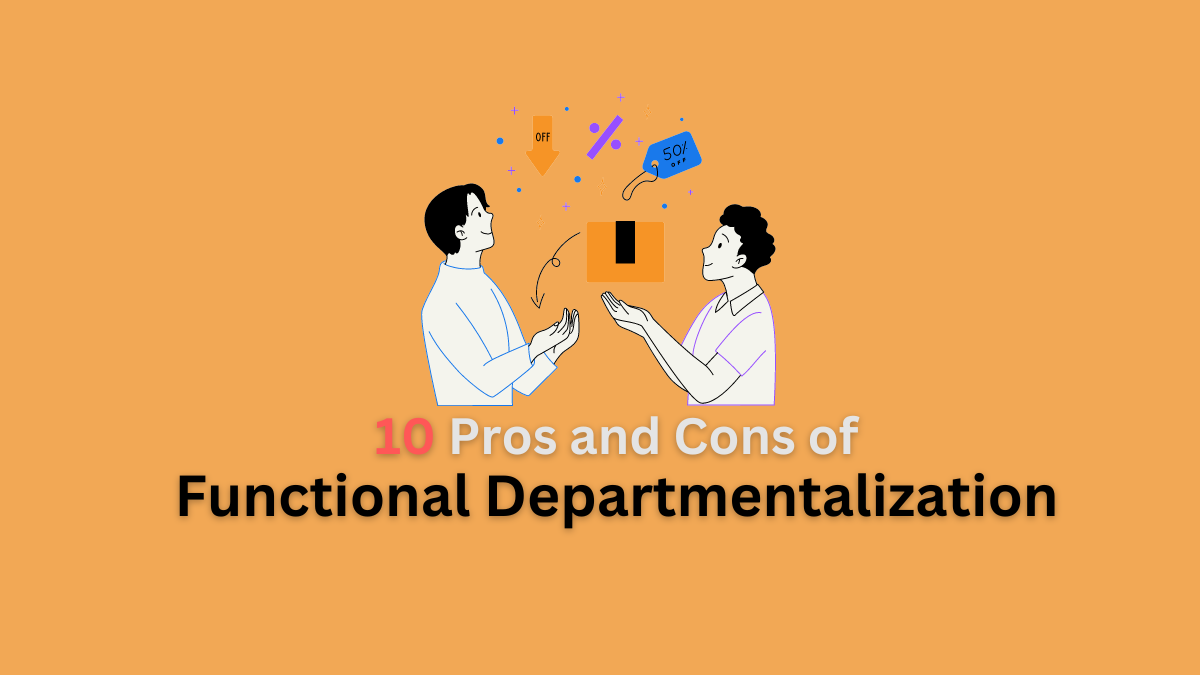Pros and Cons of Functional Departmentalization
Functional departmentalization is an organizational structure that groups jobs and tasks based on similar or related functions, such as production, marketing, finance, and human resources. This structure promotes specialization, efficient resource utilization, and streamlined operations within each functional area.
Here we will discuss about 10 major pros and cons of functional departmentalization in the workplace, so let’s get started:
Pros of Functional Departmentalization
Let’s look at the five main advantages of functional departmentalization:
Specialization
Functional departmentalization promotes specialization by grouping employees based on similar tasks and skills. This allows individuals to focus on specific functions, enhancing their expertise and efficiency. As employees perform the same tasks repeatedly, they become highly proficient, leading to higher-quality outputs.
Specialization ensures that tasks are performed with greater accuracy and expertise, which can significantly improve the overall performance and productivity of the organization.
Economies of Scale
By consolidating similar tasks within departments, organizations can achieve economies of scale. This means that resources, including time, money, and materials, are utilized more efficiently, reducing duplication of efforts and costs. Economies of scale result in cost savings for the organization, making operations more cost-effective and enhancing profitability.
Enhanced Coordination Within Departments
Functional departmentalization simplifies coordination within departments. Managers can easily synchronize activities and unify the efforts of personnel working on similar tasks, ensuring that everyone is aligned with departmental goals.
Improved coordination leads to smoother workflows, fewer misunderstandings, and better departmental and organizational objectives achievement.
Focused Training and Supervision
Employees within a department receive specialized training relevant to their specific functions, ensuring they develop the necessary skills and knowledge. Supervisors can provide focused oversight, guidance, and support tailored to the tasks.
Focused training and supervision enhance employee competency, increasing productivity and job satisfaction. It also ensures that employees are well-prepared to handle their specific roles effectively.
Read More: 10 Major Pros and Cons of Job Enrichment
Clear Control and Accountability
Functional departmentalization establishes clear lines of control and accountability. Department heads or managers are responsible for the performance and outcomes of their units, ensuring that there is a clear structure for decision-making and performance assessment.
Clear accountability helps in setting precise performance expectations and facilitates effective management, leading to better control over departmental activities and outcomes.
Cons of Functional Departmentalization
Now, let’s explore the five main drawbacks of functional departmentalization in the organization:
Slower Decision-Making
The hierarchical structure and centralized authority in functional departmentalization can slow down decision-making processes. Decisions often need approval from multiple levels of management, which can delay responses to market changes or emerging issues.
Slower decision-making can hinder the organization’s ability to react swiftly to external challenges or opportunities, potentially affecting its competitiveness and agility.
Read More: 10 Major Pros and Cons of Line Organization
Compartmentalization of Objectives
Departments may prioritize their individual goals over the organization’s overall objectives. This can lead to a lack of alignment and cooperation between departments, as each focuses on optimizing its functions rather than contributing to the broader mission.
Misaligned objectives can result in inefficiencies, missed opportunities for synergy, and conflicts between departments, ultimately impeding the organization’s overall performance.
High Supervision Costs
Functional departmentalization often requires multiple supervisors to oversee specialized tasks within each department. This increases the number of managerial positions, leading to higher supervision costs.
Higher supervision costs can strain the organization’s budget, reducing the financial resources available for other critical areas such as innovation, employee development, or market expansion.
Read Next: 10 Major Pros and Cons of Matrix Organization in Business
Reduced Innovation and Creativity
The emphasis on specialized roles and repetitive tasks can stifle creativity and innovation. Employees may become complacent within their specific functions and be less likely to think outside the box or propose new ideas.
A lack of innovation and creativity can make it difficult for the organization to adapt to changing market conditions, develop new products or services, and maintain a competitive edge.
Difficulty in Monitoring Performance
Monitoring and evaluating performance across different departments can be challenging due to the segmented nature of functional departmentalization. It can be hard to measure the contribution of each department to the overall organizational goals.
Difficulty in performance monitoring can lead to issues in accountability, with some departments potentially underperforming without timely identification and corrective action. This can negatively impact the organization’s overall effectiveness and efficiency.
In summary, functional departmentalization offers significant advantages such as enhanced specialization, economies of scale, and improved coordination within departments. However, it also presents challenges including slower decision-making, high supervision costs, and reduced innovation.
Read Next: 10 Major Pros and Cons of SWOT Analysis in Business
